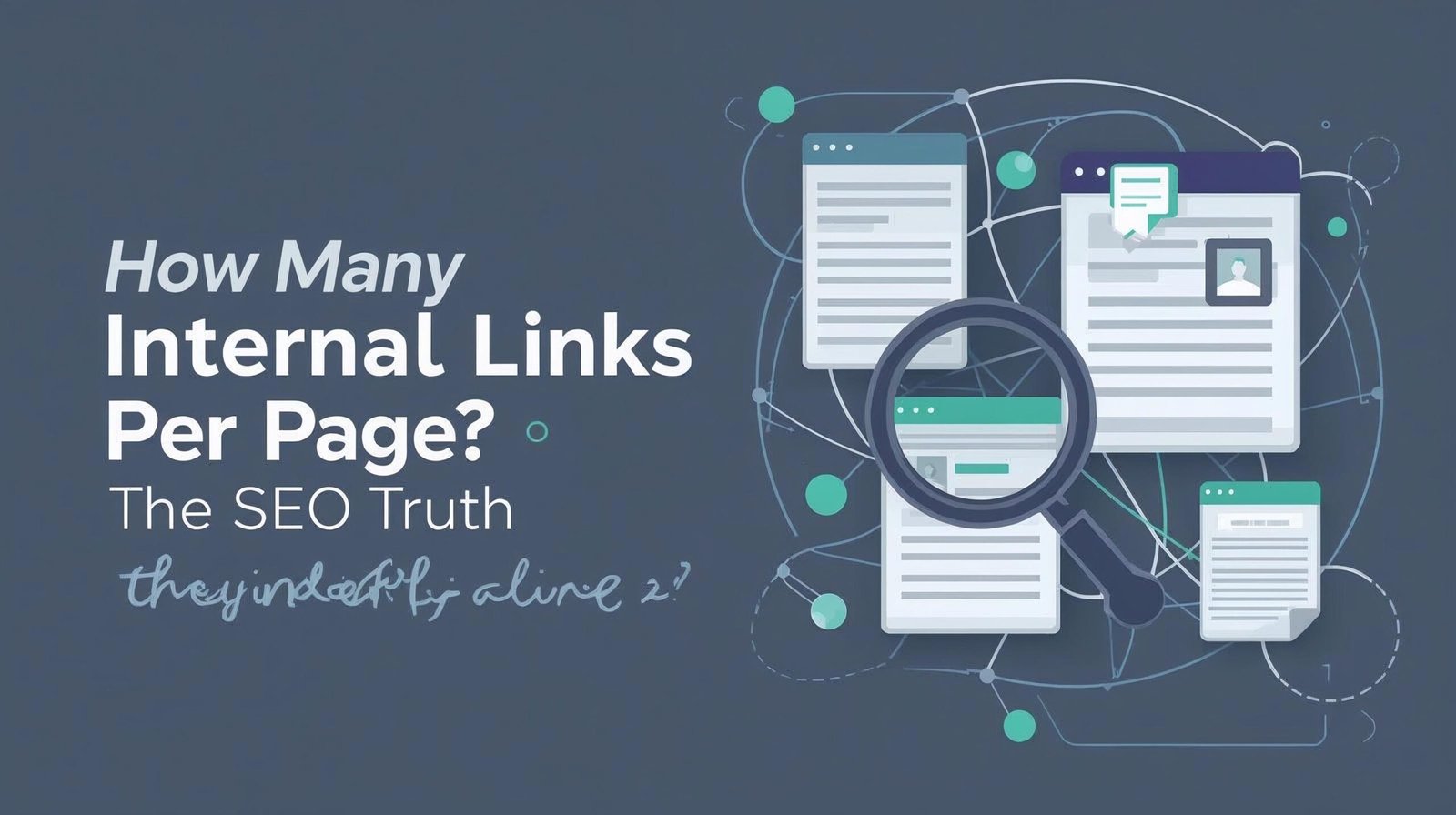Subtotal $0.00
Summary
Internal links are hyperlinks that connect pages within the same website and play a crucial role in SEO. They help search engines efficiently crawl and index pages, distribute link authority (or “link juice”), and enhance user experience by guiding visitors to related content. While there’s no fixed rule for how many internal links a page should have, SEO experts generally recommend a balanced number—typically around 5 to 10 internal links per 2,000 words. Excessive internal links can dilute SEO value and confuse both users and search engines. The focus should be on quality, relevance, and natural placement of links, using descriptive anchor text and regularly auditing the link structure to maintain site health. Proper internal linking improves rankings, boosts organic traffic, and creates a seamless navigation experience for users, making it a vital SEO strategy in 2025 and beyond.
Ever wondered how many internal links you should include on each page of your website to boost SEO without hurting the user experience? Internal linking is one of those SEO tactics that many know is important but few understand how to wield effectively. Too few links, and your site’s structure looks flat and isolated. Too many links, and you risk overwhelming both users and search engines, diluting your page authority.
This post dives deep into the SEO truth about how many internal links per page you should use. Whether you’re an SEO expert, learner, or someone curious about optimizing your website, you’ll gain actionable insights backed by research, expert opinions, and practical examples. By the end, you’ll know how to craft a smart internal linking strategy that helps Google crawl your site better and guides users naturally—without stuffing or confusion.
What Are Internal Links and Why Do They Matter?
Internal links are hyperlinks on a webpage that point to other pages within the same website. Unlike external links, which direct users to a different domain, internal links keep visitors navigating within your digital property.
Why Internal Links Are Critical for SEO
- Help Search Engines Crawl Your Site Efficiently: Googlebot and other crawlers use internal links as pathways to discover and index your pages. A good structure ensures important pages get found and ranked faster.
- Distribute Link Authority (Link Juice): Internal links pass ranking signals and authority from one page to another. This helps highlight your most valuable content to search engines.
- Enhance User Experience: Properly placed internal links guide visitors to related content, keeping them engaged longer, reducing bounce rates, and improving conversions.
- Build Site Hierarchy: Internal links help organize your content into topic clusters and site architecture, making it easier for both humans and bots to understand your website’s structure.
Think of your website as a garden and internal links as the paths guiding visitors from one beautiful area to another. Without well-planned paths, visitors might get lost or leave early.
How Many Internal Links Per Page? The Current SEO Insights
There Is No One-Size-Fits-All Number
Google has never set a strict limit on the number of internal links per page. However, there are well-accepted guidelines that SEO experts and industry research recommend.
- Moz and Industry Experts: Generally suggest around 5 to 10 internal links per 2,000 words, roughly one link every 200–300 words. This keeps links natural and contextually relevant.
- John Mueller from Google: Warns against “too many links” that dilute the page’s focus and make it harder for crawlers to understand the priority of content. Pages with over 150 links can risk not being crawled fully.
- Zyppy SEO Study (2025): Analyzed 23 million internal links and found pages with 45 to 50 internal links tend to get the best organic traffic lift. Beyond that, too many links started to reduce effectiveness.
Commonly Cited Rules of Thumb
| Content Length | Typical Internal Links Recommendation |
|---|---|
| 500 words | 2-5 internal links |
| 1,000 words | 4-7 internal links |
| 2,000 words | 5-10 internal links |
| Longer pages (5,000+) | Up to 50+ internal links (if relevant) |
Remember, this includes all internal links on that page, including those in headers, footers, sidebars, and main content.
Factors Influencing the Number of Internal Links Per Page
1. Content Length and Depth
Longer, more in-depth content naturally supports more internal links because there is more context and opportunity to link relevant pages.
2. Purpose and Page Type
- Homepages and category pages tend to have more internal links because they serve as hubs.
- Blog posts typically have fewer—enough to link to related articles or cornerstone content.
- Product pages may have strategic links to guides, categories, or upsells.
3. Relevance and Contextual Placement
Every internal link should serve a clear purpose and add value to the reader’s journey. Irrelevant or forced links can confuse both users and search engines, diluting SEO strength.
4. User Experience Considerations
Too many links create cognitive overload and can appear spammy. A well-balanced number ensures users are guided smoothly through meaningful content.
5. Site Architecture and Overall Internal Linking Strategy
Your internal link quantity also depends on the number of pages your site has and your linking goals. Bigger sites might need more links spread strategically to distribute authority efficiently.
Best Practices for Internal Linking in 2025
Quality Over Quantity
Focus on relevant, contextually placed internal links rather than just hitting a numerical quota. Each link should provide SEO value and improve user experience.
Use Descriptive and Specific Anchor Text
Anchor text should clearly indicate what the linked page is about—avoid vague text like “click here.” This helps Google understand the topic relevance better.
Prioritize Placement
Links placed higher in the content or body tend to carry more SEO weight than those buried in footers or sidebars.
Avoid Link Stuffing and Overlinking
Too many links can dilute page authority and make your site look spammy to both users and search engines. Strike a balance.
Utilize Navigation Elements Wisely
Headers, footers, breadcrumbs, and sidebars should help users and search engines find key pages, but don’t overpopulate these areas.
Regularly Audit Your Links
Websites evolve, so ongoing audits help find broken links, orphaned pages, or opportunities to add fresh internal links, keeping your site healthy.
Leverage Internal Linking Tools
Plugins like AIOSEO’s Link Assistant can help identify linking opportunities, manage anchors, and find underlinked pages for better internal link distribution.
Common Mistakes and How to Avoid Them
- Overusing Internal Links: Avoid cluttering pages with dozens of links that don’t add value.
- Generic Anchor Text: Using “read more” or “click here” reduces SEO benefit and confuses users.
- Ignoring Relevance: Link only to pages that are related and useful at that point in the user’s journey.
- Failing to Update Links: When adding new content, don’t forget to link back and forth appropriately.
- Counting Non-content Links as Links: Remember that all links in headers, footers, or sidebars count toward total limits.
Practical Tips and Personal Insights
How to Audit Your Internal Links
- Use SEO tools (Screaming Frog, SEMrush, Ahrefs) to crawl your site and list all internal links.
- Identify pages with too few or no internal links.
- Spot orphaned pages and strategically add links to them.
- Check anchor text for relevance and diversity.
Real-World Example
Imagine a bicycle e-commerce website that links multiple product pages to a detailed bike fitting guide. This guide gathers internal link authority and is then used to link to newly launched products, helping Google assign importance efficiently.
Prioritize Your Most Valuable Pages
Pinpoint cornerstone content, top-selling products, or key informational guides, and ensure they receive adequate internal link support from relevant pages.
Conclusion
There isn’t a universal number of internal links that fits every page or site. The best approach is a thoughtful, strategic balance—aim for around 5 to 10 links per 2,000 words, but always prioritize relevance, user experience, and natural placement.
Internal linking is a powerful yet delicate component of SEO. Done right, it boosts crawlability, enhances site hierarchy, helps distribute authority, and improves user engagement. Too many irrelevant or poorly placed links can harm your efforts.
Start auditing your website’s internal links today. Add purposeful links that matter and consider using tools to optimize your strategy. The right internal linking can boost your rankings and create a seamless user journey that keeps visitors coming back.
If this post helped clarify the SEO truth about internal linking, why not dive deeper into related SEO topics? Leave a comment with your questions or share your internal linking strategies below!
This comprehensive post combines best practices, expert advice, and research-backed data to equip SEO professionals, learners, and anyone curious with the knowledge to optimize internal links effectively in 2025.
FAQ
What is an internal link in SEO?
An internal link is a hyperlink that points from one page to another within the same website, helping both users and search engines navigate the site effectively.
How many internal links should I have on a single page?
While there is no strict limit, SEO experts suggest around 5 to 10 internal links per 2,000 words, balancing relevance and user experience.
Can having too many internal links hurt my SEO?
Yes, excessive internal links can dilute page authority, confuse users, and potentially hinder search engine crawl efficiency.
What makes a good internal link anchor text?
Effective anchor text is descriptive, relevant, and concise, clearly indicating what the linked page is about.
How often should I audit and update my internal links?
Regular audits, ideally quarterly or after adding new content, help maintain a healthy internal linking structure and ensure no broken or orphaned pages.






